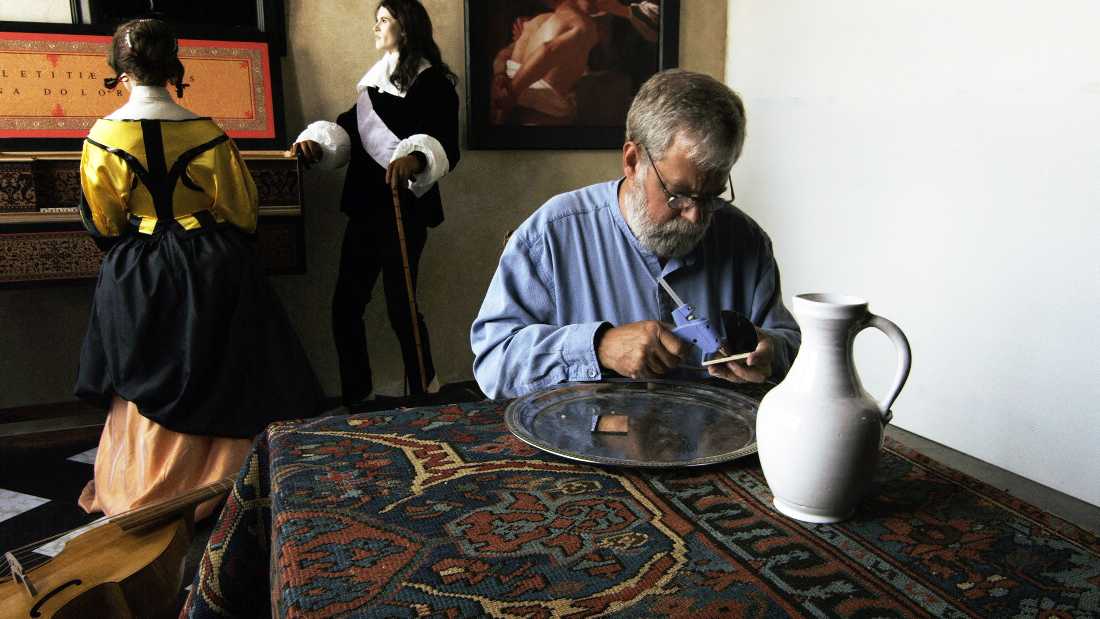The enthralling documentary Tim’s Vermeer made a big splash when it opened last year’s Lone Star Film Festival, and this weekend it comes to the Modern Art Museum of Fort Worth, where it will surely find an appreciative audience. This highly enjoyable movie isn’t just for art history scholars but for everyone who can appreciate going to lengths to prove a point.
Our subject is San Antonio inventor and video engineer Tim Jenison, a personal friend of magician Penn Jillette with a theory about Johannes Vermeer. Picking up on ideas advanced by the art historian Philip Steadman and the famed painter David Hockney, Tim believes that the 17th-century Dutch artist used optical devices to help him capture the wondrous detail in his paintings. Since no one has tested these controversial theories, Tim resolves to use optical technology from that time to reproduce the artist’s painting “The Music Lesson” despite having no training as an artist himself. Penn (the movie’s narrator) and his stage partner Teller (the director) follow the fiftysomething Tim as his quest stretches over five years.
This project becomes Tim’s all-consuming obsession, spurring him to learn Dutch and repeatedly visit Vermeer’s hometown of Delft. He rents a warehouse in San Antonio and creates a life-size replica of the room depicted in “The Music Lesson,” learning how to mix paints, grind lenses, tile floors, plaster walls, glaze windows, weave carpets, sew costumes, make furniture, and build a virginal (a type of harpsichord), all to 17th-century Dutch specifications. Through it all, both we and Tim are buoyed by the success of an experiment that we see early in the film, in which he uses his technique to paint a copy of his father-in-law’s high-school yearbook photo. The stunning clarity of his reproduction is a “holy crap” moment.
As illusionists, Penn and Teller appreciate the wizardry that Tim is trying to achieve. As entertainers, they know how to make a tidy, breezy 80-minute movie out of this sprawling saga. Tim himself shows a wry sense of humor about the enterprise, and the filmmakers add their own funny asides. When Tim has his youngest daughter spend her Christmas break standing still for hours on end to model for the young woman in the painting, Penn notes, “No college student was ever happier to go back to school.” Penn and Teller give no screen time to detractors of Tim’s theory, which may not be kosher for documentarians, but it does help keep out the hectoring, intellectually superior tone that sometimes creeps into their entertainments.
The main objection art historians have to Tim’s supposition is an emotional one: The idea that Vermeer used lenses to paint his masterpieces seems like cheating. Yet while Tim’s Vermeer convinced me that Tim is right, it didn’t leave me feeling like the great artist was a fraud. When Vermeer’s naked eye and his hands weren’t enough to realize the indelible visions that he saw in his head, he invented a new technology to help put them onto canvas, where we can see them today. That is awe-inspiring genius, and Tim Jenison’s indomitable patience and doggedness gives us an enticing sense of how it all came about.
[box_info]
Tim’s Vermeer
Starring Tim Jenison. Directed by Teller. Written by Penn Jillette and Teller. Rated PG-13. Fri-Sun at the Modern Art Museum of Fort Worth, 3200 Darnell St, FW. $7-9. 817-738-9215.
[/box_info]












